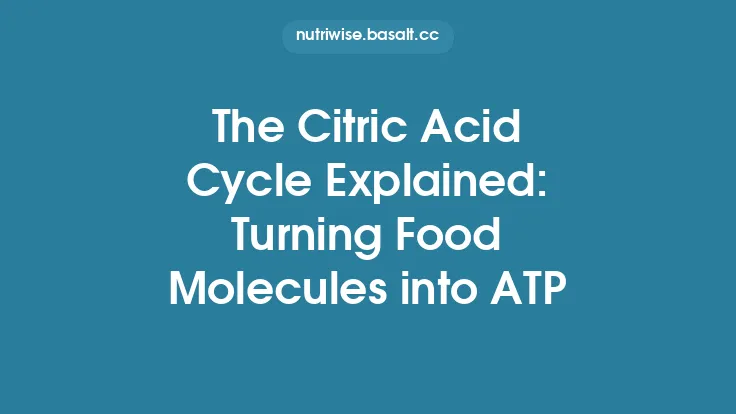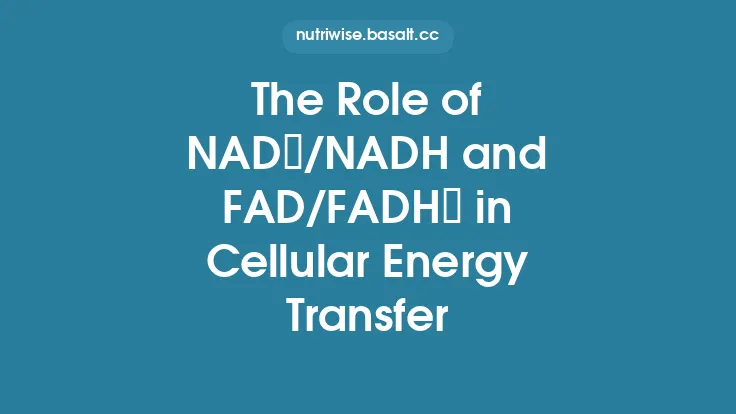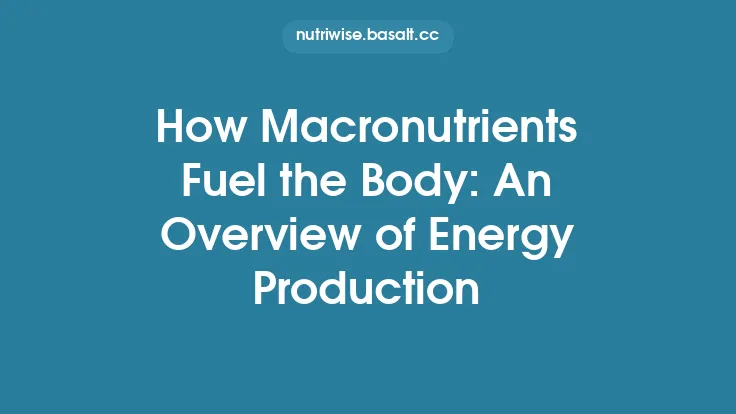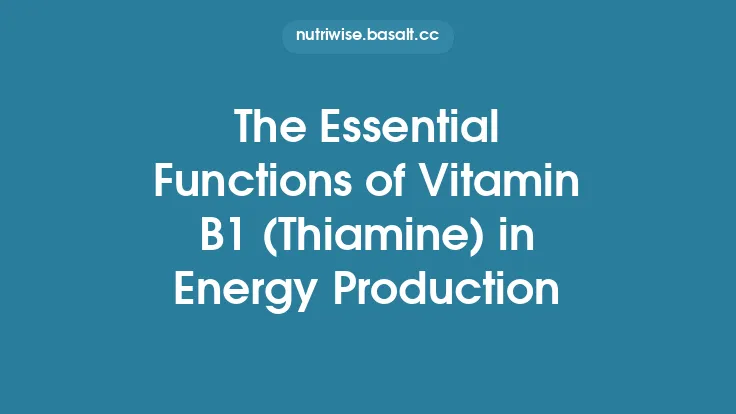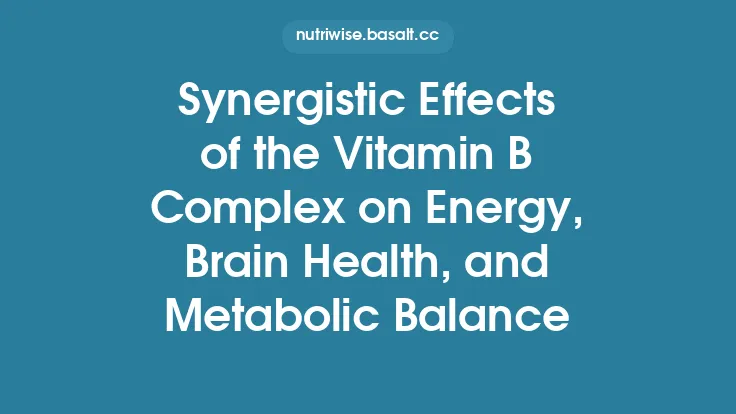The conversion of the food we eat into usable cellular energy is a marvel of biochemistry, and at its heart lies adenosine‑triphosphate, or ATP. This small molecule functions as the universal energy currency of the cell, coupling the exergonic breakdown of nutrients to the endergonic processes that sustain life. Understanding how ATP is generated, stored, and utilized provides a window into the intricate choreography of enzymes, membranes, and molecular gradients that power every heartbeat, nerve impulse, and muscle contraction.
The Chemical Nature of ATP
ATP is a nucleotide composed of three parts: a nitrogenous base (adenine), a ribose sugar, and a chain of three phosphate groups. The high‑energy bonds between the phosphate groups—specifically the phosphoanhydride bonds linking the β‑ and γ‑phosphates—store potential energy that can be released upon hydrolysis:
\[
\text{ATP} + \text{H}_2\text{O} \rightarrow \text{ADP} + \text{P}_i + \Delta G^\circ' \approx -30.5\ \text{kJ·mol}^{-1}
\]
The negative free‑energy change makes this reaction highly favorable, and the released energy can be harnessed to drive a wide array of cellular processes, from mechanical work (muscle contraction) to chemical synthesis (protein biosynthesis).
Pathways of ATP Production
1. Substrate‑Level Phosphorylation
Substrate‑level phosphorylation directly transfers a phosphate group from a high‑energy metabolic intermediate to ADP, forming ATP without the involvement of a membrane gradient. Two major cellular contexts employ this mechanism:
- Glycolysis – In the cytosol, the enzyme phosphoglycerate kinase transfers a phosphate from 1,3‑bisphosphoglycerate to ADP, and later, pyruvate kinase converts phosphoenolpyruvate (PEP) to pyruvate while generating a second ATP molecule per glucose.
- Citric Acid Cycle (TCA) – Within the mitochondrial matrix, succinyl‑CoA synthetase catalyzes the conversion of succinyl‑CoA to succinate, producing GTP (which can be readily converted to ATP by nucleoside diphosphate kinase).
Although substrate‑level phosphorylation yields only a modest amount of ATP per molecule of glucose, it provides a rapid, oxygen‑independent source of energy, especially important in anaerobic conditions.
2. Oxidative Phosphorylation
The bulk of cellular ATP—approximately 90 % in aerobic eukaryotes—is synthesized by oxidative phosphorylation, a process that couples the oxidation of reduced cofactors (NADH, FADH₂) to the phosphorylation of ADP. This occurs across the inner mitochondrial membrane and involves two tightly linked components:
- Electron Transport Chain (ETC) – A series of protein complexes (I–IV) and mobile carriers (ubiquinone, cytochrome c) that pass electrons from NADH and FADH₂ to molecular oxygen, the final electron acceptor. As electrons flow through the chain, protons are pumped from the matrix into the intermembrane space, establishing an electrochemical gradient (the proton motive force, Δp).
- ATP Synthase (Complex V) – A rotary enzyme that harnesses the energy stored in Δp. Protons re‑enter the matrix through the F₀ subunit, driving rotation of the central stalk (γ‑subunit) and inducing conformational changes in the catalytic β‑subunits of the F₁ head, which synthesize ATP from ADP and inorganic phosphate.
The chemiosmotic theory, first articulated by Peter Mitchell, elegantly explains how the free energy of electron transfer is conserved as a proton gradient and then converted into the chemical bond energy of ATP.
Integration of Macronutrient Catabolism with ATP Generation
While the focus here is on ATP biochemistry, it is useful to note how the three macronutrients converge on the same energy‑producing machinery:
- Carbohydrates – Glucose is metabolized through glycolysis to pyruvate, which is oxidized to acetyl‑CoA, feeding the TCA cycle.
- Fats – Fatty acids undergo β‑oxidation, producing acetyl‑CoA, NADH, and FADH₂ that enter the TCA cycle and ETC.
- Proteins – Amino acids are deaminated and their carbon skeletons are converted into TCA intermediates (e.g., α‑ketoglutarate, oxaloacetate), thereby contributing to ATP synthesis.
Thus, regardless of the original nutrient, the final common pathway for ATP production is the mitochondrial oxidative phosphorylation system.
Cellular Energy Charge and Its Regulation
The energy charge (EC) of a cell is a dimensionless ratio that reflects the relative concentrations of ATP, ADP, and AMP:
\[
\text{EC} = \frac{[\text{ATP}] + 0.5[\text{ADP}]}{[\text{ATP}] + [\text{ADP}] + [\text{AMP}]}
\]
A healthy, metabolically active cell maintains an EC between 0.8 and 0.95. Deviations trigger regulatory mechanisms:
- Allosteric Enzyme Control – High ATP levels inhibit key catabolic enzymes (e.g., phosphofructokinase‑1 in glycolysis), while elevated ADP or AMP relieve inhibition, accelerating ATP production.
- Adenylate Kinase – Catalyzes the reversible reaction 2 ADP ⇌ ATP + AMP, helping buffer ATP levels during rapid demand.
- Creatine Kinase System – In tissues with fluctuating energy needs (muscle, brain), phosphocreatine serves as a rapid ATP reserve: Cr + ATP ⇌ PCr + ADP. The reversible reaction buffers ATP concentrations on a sub‑second timescale.
These feedback loops ensure that ATP supply matches demand, preventing wasteful overproduction and protecting the cell from energy deficits.
Transport of ATP Across Cellular Compartments
Although the majority of ATP is synthesized in mitochondria, many cellular processes occur in the cytosol, nucleus, or other organelles. ATP must therefore be shuttled efficiently:
- Adenine Nucleotide Translocase (ANT) – An inner‑membrane carrier that exchanges matrix ATP for cytosolic ADP, maintaining a high ATP/ADP ratio in the matrix while supplying the cytosol.
- Phosphate Carriers – The mitochondrial phosphate carrier imports inorganic phosphate (Pᵢ) into the matrix, a prerequisite for ATP synthesis.
- Vesicular Transport – Certain organelles (e.g., the endoplasmic reticulum) possess ATP‑dependent transporters that import ATP directly from the cytosol for lumenal processes such as protein folding.
The coordinated activity of these transporters preserves the energetic continuity across cellular compartments.
ATP Utilization: Coupling Energy Release to Work
The hydrolysis of ATP is not merely a source of heat; it is a coupling reaction that drives otherwise unfavorable processes. The principle of energy coupling can be illustrated by several archetypal examples:
- Mechanical Work – Myosin heads in muscle fibers bind ATP, hydrolyze it, and undergo conformational changes that generate force and movement.
- Active Transport – The Na⁺/K⁺‑ATPase pumps three Na⁺ ions out and two K⁺ ions into the cell per ATP hydrolyzed, maintaining electrochemical gradients essential for nerve impulse propagation.
- Biosynthesis – Ribosomal peptide bond formation, DNA polymerization, and lipid synthesis each require the energy supplied by ATP (or its equivalents, such as GTP) to drive condensation reactions.
- Signal Transduction – Kinases transfer the γ‑phosphate of ATP to target proteins (phosphorylation), modulating their activity and propagating cellular signals.
In each case, the free energy released from ATP hydrolysis is harnessed to lower the activation energy of the coupled reaction, making it thermodynamically feasible.
The Role of Mitochondrial Dynamics in ATP Production
Mitochondria are not static organelles; their shape, distribution, and connectivity influence ATP output:
- Fission and Fusion – Balanced fission (division) and fusion (joining) maintain mitochondrial health, optimize respiratory efficiency, and allow rapid adaptation to metabolic demands.
- Cristae Architecture – The inner membrane folds (cristae) increase surface area for ETC complexes and ATP synthase, directly affecting the capacity for oxidative phosphorylation.
- Mitochondrial Biogenesis – Upregulation of nuclear‑encoded mitochondrial genes (e.g., via PGC‑1α) expands the mitochondrial network, enhancing the cell’s maximal ATP‑producing potential.
These structural aspects are integral to the biochemical efficiency of ATP generation, underscoring that the process is as much about organization as it is about chemistry.
ATP Turnover: A Quantitative Perspective
The human body turns over its entire ATP pool many times per minute. Rough estimates illustrate the scale:
- Resting Adult – Approximately 2 × 10⁵ mol of ATP are hydrolyzed each day, equivalent to the body’s total ATP pool being regenerated every 3–5 minutes.
- Intense Exercise – Skeletal muscle can hydrolyze up to 100 mol of ATP per minute, requiring rapid replenishment via phosphocreatine, glycolysis, and oxidative phosphorylation.
Such high turnover rates demand a tightly regulated, highly efficient system to avoid energy shortfalls.
Pathological Implications of Impaired ATP Biochemistry
Disruptions in any component of ATP metabolism can have profound consequences:
- Mitochondrial Diseases – Mutations in ETC complexes or ATP synthase subunits reduce oxidative phosphorylation efficiency, leading to neuromuscular weakness, neurodegeneration, and metabolic crises.
- Ischemia – Oxygen deprivation halts the ETC, causing rapid depletion of ATP, loss of ion gradients, and cell death.
- Metabolic Disorders – Defects in substrate‑level phosphorylation enzymes (e.g., pyruvate kinase deficiency) impair ATP generation in red blood cells, resulting in hemolytic anemia.
Understanding the precise biochemistry of ATP provides a foundation for therapeutic strategies aimed at restoring cellular energy balance.
Emerging Frontiers in ATP Research
While the core mechanisms of ATP production are well established, ongoing research continues to refine our knowledge:
- Supercomplex Formation – Recent structural studies reveal that ETC complexes can assemble into “respirasomes,” potentially enhancing electron transfer efficiency.
- Alternative Oxidases – Some organisms possess non‑canonical pathways that bypass Complexes III and IV, offering insights into flexible energy strategies.
- Synthetic Biology – Engineering microbes with optimized ATP‑generating pathways holds promise for bio‑fuel production and biomanufacturing.
These advances illustrate that even a molecule as familiar as ATP remains a vibrant subject of scientific inquiry.
Concluding Remarks
ATP stands at the nexus of nutrition, biochemistry, and physiology. From the moment a carbohydrate, fat, or protein molecule is broken down into its constituent building blocks, the resulting carbon skeletons are funneled through a series of meticulously orchestrated reactions that culminate in the synthesis of ATP. This molecule then serves as the immediate source of energy for virtually every cellular activity, its hydrolysis tightly coupled to the work that sustains life.
The elegance of ATP biochemistry lies in its universality and adaptability: a single chemical entity, produced by diverse metabolic routes, powers the myriad processes that define living organisms. By appreciating the detailed mechanisms—substrate‑level phosphorylation, the electron transport chain, chemiosmotic coupling, and the sophisticated regulatory networks that maintain energy charge—we gain a deeper understanding of how the food we consume is transformed into the kinetic and chemical energy that fuels our bodies every second of every day.
